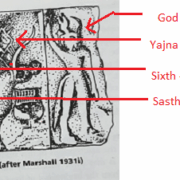Sixth Day belongs to god Shasti -.
Sixth day belongs to God Shashti
Abstract
The sixth day of the calendar is associated with God Shashti. It is a female god in Bengal and eastern India, whereas it was a male god in south India. Most probably Shashti was a malevolent male god in Indus Valley civilization.
Shashti (literally “sixth”) is a Hindu goddess, venerated in Nepal and India as the benefactor and protector of children. She is also the deity of vegetation and reproduction and is believed to bestow children and assist during childbirth. She is often pictured as a motherly figure, riding a cat and nursing one or more infants. She is symbolically represented in a variety of forms, including an earthenware pitcher, a banyan tree or part of it or a red stone beneath such a tree; outdoor spaces termed shashthitala are also consecrated for her worship. The worship of Shashthi is prescribed to occur on the sixth day of each lunar month of the Hindu calendar as well as on the sixth day after a child’s birth. Barren women desiring to conceive and mothers seeking to ensure the protection of their children will worship Shashthi and request her blessings and aid. She is especially venerated in eastern India.
Most scholars believe that Shashthi’s roots can be traced to Hindu folk traditions. References to this goddess appear in Hindu scriptures as early as 8th and 9th century BCE, in which she is associated with children as well as the Hindu war-God Skanda. Early references consider her a foster-mother of Skanda, but in later texts she is identified with Skanda’s consort, Devasena. In some early texts where Shashthi appears as an attendant of Skanda, she is said to cause diseases in the mother and child, and thus needed to be propitiated on the sixth day after childbirth. However, over time, this malignant goddess became seen as the benevolent saviour and bestower of children.
The below given table, shows the frequency of occurrence of the symbol of number six. This data is extracted from the research paper of Sundar et al (1). Number six appears in association with fish symbol as well as Sastha (God) symbol. The ‘sixth day god’ (Shashti) is a meaningful association, whereas sixth day ‘Pithru’ (ancestor)is not a meaningful association.
| Symbols combination | frequency | God associated with calendar day |
 |
16 | Here in this combination the sixth day is associated with fish symbol (Pithrus)/ (Ancestors). Generally, the sixth day is related to the goddess Shashti. Even though Pithru symbol is associated with sixth day here, it may not be a correct combination. The association of fish symbol with adjoining symbol has to be studied. |
 |
10 | The sixth day is also associated with the ‘Sastha’ (God) symbol. No specific god is mentioned. But in all probability, it was God Shashti. |
It is not clear, the god shashti is female or male god. In modern day Bengal and orissa, god of sixth day is associated with female goddess, whereas in south India it is a male god skanda/muruga. The picture of shashti shown in Indus seal does not clear the issue. The sex of the god is not specified, most probably, it looks like a male god. (See the seal pictures below)
The above given pictures are extracted from book of Asko Parpola (1) It is a double sided seal, in which the name of the god Shashti is written as sixth-day sastha (god).
Another seal showing god Shasti. The inscription reads as following:
Yajna performed for the sixthday
sastha
(For shasti)- double offering
.
Bibliography
1. Sundar. -The-Indus-Script-Text-and-Context.pdf. http://45.113.136.87/wp-content/uploads/. [Online] http://45.113.136.87/wp-content/uploads/43-The-Indus-Script-Text-and-Context.pdf.
2. Parpola, Asko. Deciphering the Indus Script. New Delhi. : Cambridge University Press., 2000.




